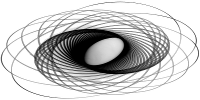Design Intent Detection
- Design Intent Detection[More]
Our approach is based on two ideas: (1) decomposing a model into suitable sub-parts simplifies finding regularities, which are less ambiguous compared to analysing the model as one part; and (2) detecting approximate symmetries and related regularities reveals a likely design intent description, but requires careful handling of tolerances to reduce the inconsistency between the ...
Publications
- [Details]
M. Li, F. C. Langbein, R. R. Martin. Detecting Design Intent in Approximate CAD Models Using Symmetry. Computer-Aided Design, 42(3):183-201, 2010.
- [Details]
F. C. Langbein, M. Li, R. R. Martin. A Comment on ‘Constructing Regularity Feature Trees for Solid Models’. In: Advances in Geometric Modeling and Processing, Proc. Geometric Modelling and Processing, Springer LNCS, 4975:603, 2008.
- [Details]
M. Li, F. C. Langbein, R. R. Martin. Detecting Approximate Symmetries of Discrete Point Subsets. Computer-Aided Design, 40(1):76-93, 2008.
- [Details]
M. Li, F. C. Langbein, R. R. Martin. Detecting Approximate Incomplete Symmetries in Discrete Point Sets. In: Proc. ACM Symp. Solid and Physical Modeling, pp. 335-340, ACM Siggraph 2007.
- [Details]
M. Li, X.-S. Gao, S.-C. Chou. Quadratic Approximation to Plane Parametric Curves and its Application in Approximate Implicitization. The Visual Computer, 22(9-11):906-917, 2006.
- [Details]
M. Li, F. C. Langbein, R. R. Martin. Constructing Regularity Feature Trees for Solid Models. In: M.-S. Kim, K. Shimada (eds), Proc. Geometric Modeling and Processing, Springer LNCS, 4077:267-286, 2006.
Presentations
- [Details]
F. C. Langbein. Reverse Engineering: From Artifacts to Concepts. Public engagement and outreach talk given at various occasions.
- [Details]
F.C. Langbein. Design Intent of Geometric Models. Invited seminar talk, Institute of Information and Mathematical Sciences, Massey University at Albany, 22nd September 2004.
- [Details]
F. C. Langbein. Design Intent of Geometric Models. Invited seminar talk, Dept. Computer Science, Auckland University, 15th September 2004.
- [Details]
FC Langbein. Design Intent of Reverse Engineered Geometric Models. Dept. Computer Science, Cardiff University, 17th July, 2002.
Codes
Engagement
- [Details]
F. C. Langbein. Reverse Engineering: From Artifacts to Concepts. Public engagement and outreach talk given at various occasions.
Partners
Ming Li
State Key Laboratory of CAD&CG, Zhejiang University, Hangzhou, China.Ralph R Martin
School of Computer Science and Informatics, Cardiff University, Cardiff, UK.Frank C Langbein
School of Computer Science, Cardiff University, Cardiff, UK.
Funding
- [Details]
July 2004 – July 2007: Detection of Design Intent in Complex Approximate Geometric Models. EPSRC GR/S69085/01. PI: F. C. Langbein. £123,639.
